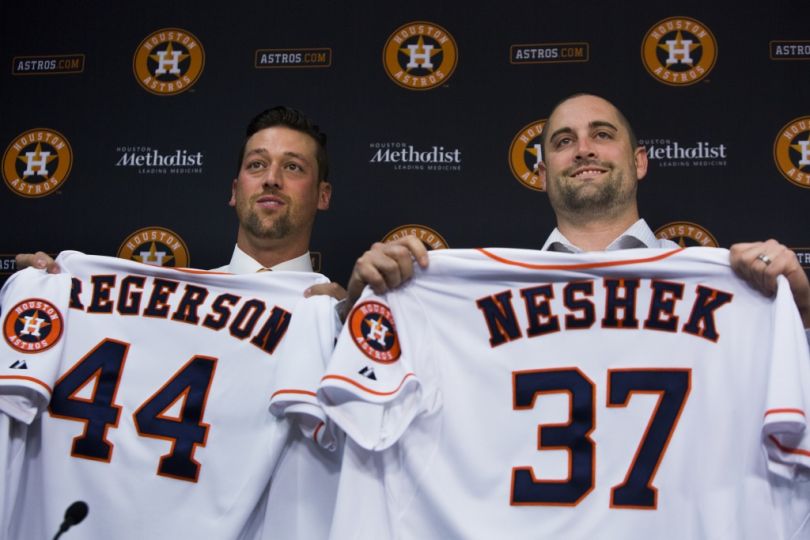As the 2015 MLB Season approached, ESPN and other sources came to an unexpected conclusion: the Houston Astros, who had lost more than 100 games in each of the last three years, would become American League West Champions—soon. Sports Illustrated took this questionable take a leap further, anointing the Astros as World Series Champions in 2017. This team has seen such a gradual rise and fall in the past ten years that this would be extremely unlikely, except for three key components they have not produced on the field in decades. Although there was a cold streak in the past two weeks, losing eight of nine before winning five straight, these factors held water through 60 games, which was how all of these statistics are measured and analyzed.
- Solid Offensive Statistics Despite Anemic Batting Averages
The team is batting .234 but has 78 home runs, leading all of baseball, and while only a third of batters reaches base, they nearly have a .800 OPS, leaving few baserunners behind. Also, four players with more than 10 doubles and 50 steals increase pressure on pitching and defense, causing shifts and sacrifice flies that advance runners with less than two outs. Pitchers also have a tougher time dealing with the combined speed and power throughout the batting order.
Colby Rasmus is not known for power hitting, but leads the teams in doubles and triples, while Chris Carter and DH Evan Gattis do not hit well, but have combined for over 25 home runs this year. Unlike their National League past, where pitchers could walk Jeff Bagwell or Carlos Beltran to reach the weaker 7-8-9 hitters, there is not a weak area of the lineup and low batting averages are all but erased with solid pitching.
- Strong Pitching Performances, Quality Starts, and a Top-Notch Bullpen
How can a team have a low batting average with five starters hitting under .250 and still be leading its division? It depends on the pitching and defense, much like an NFL Team that prides itself on tough defense with few points allowed, and the Astros fit this mold. Opponents are batting below .260 through 58 games, with a Top 10 ERA for the pitching staff, including the most ground ball outs. The Astros have also turned more than 50 double plays and have a Defensive Efficiency Rating of .707, ranking 8th in baseball. Houston enjoyed this type of success in 2004 and 2005, but has rarely had as dependable a bullpen as it enjoys now.
There is not much name recognition in bullpen pitching, but the Astros have finished 57 of 59 games, meaning that the bullpen pitcher responsible for the last inning(s) does not get pulled before the game ends, which even two years ago was less than a 75 percent rate. Luke Gregerson has been a formidable closer, converting 15 of 17 save opportunities, late inning relievers such as Chad Qualls, Tony Sipp, and Pat Neshek have gotten a hold or save when called upon, good enough for the fourth lowest ERA in baseball, a feat not often met for this team.

- Unprecedented Late-Inning Heroics
The typical flow of an Astros game in 2015 is as follows: one of the teams scores a run by the 4th inning, Houston keeps the score close, defense gets pitching out of jams in the middle innings, and there is an offensive explosion for the Astros in the 7th inning or later, which combines with bullpen performance well. This especially becomes notable because the Astros are nearly undefeated this year when leading in the 8th inning or later, so leads develop gradually and do not evaporate from the scoreboard. The strange thing is that the Astros are performing well under pressure, winning a vast majority of games despite leading the league in strikeouts, not all too different from last year.
The team lost a franchise record 113 games in 2014, and while that year saw over 1400 K’s, this year has yielded more than 500, slightly below pace for 1500 this year, and the team batting average is below last year, meaning that homeruns and extra base hits in late innings help stretch their chances to win. The overall difference is better bullpen pitching, more runs scored in the final innings, and more depth in starting pitching, as Dallas Keuchel alone accounts for the 3rd highest amount of innings in baseball.
The central question is can the Astros keep up solid pitching efforts, successfully transition Minor League Talent, namely top prospect Carlos Correa, to the Majors for the long-term, and continue to harness the long ball, all while staying healthy? If yes, then this team can generate a winning season, perhaps win the A.L West, and make a stretch run similar to the teams of 2004 and 2005; if not, then statistical struggles will bring a team presumably out of orbit of other contenders back down to Earth as part of their rebuilding picture.
